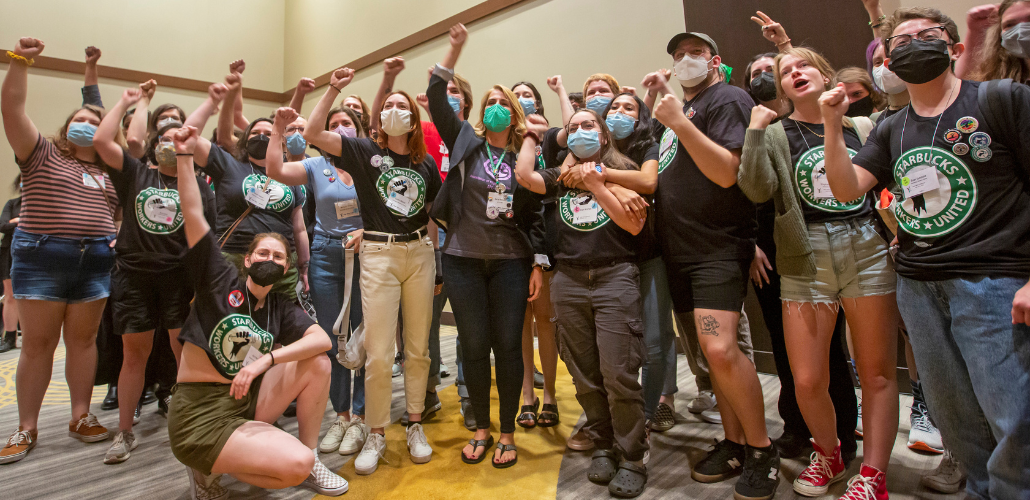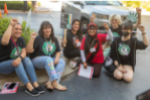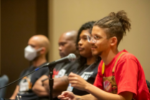A New Sense of Possibility: Starbucks and Amazon Wins Inspire Organizing at Trader Joe's, REI, Target, and Apple

Baristas from across the country gathered at the Labor Notes Conference this month. As more stores begin to push for a first contract, Starbucks Workers United is ramping up for a summer of solidarity: “We’re gonna need the whole labor movement to come out,” says Casey Moore, a barista at a Starbucks in Buffalo, the city that was home to the union’s first victory last year. Photo: Jim West
“Seven months ago if you asked me about a union I would’ve said, ‘I don’t know, cops have them?’” says Sarah Pappin, a shift supervisor at a Seattle Starbucks. But on June 6, she and her co-workers voted unanimously to join Starbucks Workers United, part of an upsurge of organizing by younger workers with little union experience that is breathing new life into the labor movement.
Now they’re dreaming even bigger. “We want to not just open the door for the rest of the food service industry, we want to kick it down,” said Pappin, who’s worked full-time at Starbucks for eight years. “Eventually you get tired of jumping to the next job and praying it’s gonna be better. You realize you should just take a stand where you have some good ground.”
The union wave at Starbucks and the Amazon Labor Union (ALU) victory on Staten Island have sparked a new sense of possibility among workers at some of the country’s biggest nonunion employers, where unions have struggled for decades to establish any sort of foothold.
Since their April win, ALU organizers say they’ve heard from workers at another 100 Amazon facilities across the country who want to unionize. And in recent months workers have filed for union elections at Trader Joe’s stores in Massachusetts and Minneapolis, an REI in Manhattan, a Target in Virginia, and Apple stores in Atlanta and Towson, Maryland.
Workers in other largely non-union sectors are also organizing, with workers at an Activision Blizzard subsidiary forming the first union at a major video game company in May and tech workers at The New York Times becoming the largest bargaining unit in tech in March.
A CASCADING EFFECT
The organizing wave is turning the labor movement’s prevailing wisdom on its head. Until now unions have mostly avoided filing for election at single workplaces that are part of big chains, like fast food restaurants or Amazon warehouses, not seeing a viable route to a first contract.
But the worker-organizers behind the current upsurge have relied on grassroots organizing to produce a cascading effect.
“The most beautiful thing about this whole movement is that we only have to win one to show what’s possible,” says Casey Moore, a barista at a Starbucks in Buffalo, the city that was home to the union’s first victory last year.
After the December vote count, Moore said, “we just started getting flooded with emails and direct messages on social media saying ‘We’re so inspired, how can we do it here?’”
Boston barista Kylah Clay was among those inspired. “We started talking about our working conditions in this new light—that we can actually change them,” she said. Clay is now helping Starbucks workers throughout New England to organize.
As we went to press, the upstart union had won elections at 177 Starbucks stores in 30 states, and lost just 30; 98 more stores had filed for elections. Workers have also struck over issues ranging from leaky ceilings and malfunctioning grease traps to cuts in hours and retaliatory firings.
Starbucks baristas have a tight workplace culture that helps explain their success. Many of the workers are younger, queer, and work there in part for the gender-affirming health benefits. “We work shoulder to shoulder in very frustrating conditions,” says Pappin. “We already know what the power of working together is.”
VIDEOS: Starbucks and Amazon Workers at the Labor Notes Conference
Check out the livestreamed sessions from the 2022 Labor Notes Conference, including:

A Union Brews at Starbucks:
Hear from seven workers who have organized their own stores, gone on strike, built public support, and caught the national imagination. Watch video.

Amazon Workers in Motion:
Rank-and-file workers from four different groups across the country describe how they’re organizing at the corporate giant, from union recognition drives to direct action on the job. Watch video.

Labor’s Upsurge: How Unions Can Make the Most of This Moment:
Veteran labor strategists and organizers from the front lines of Amazon and Starbucks discuss how unions can build on the current momentum. Watch video.
Photos: Jim West
DIRECTED FROM BELOW
The level of self-direction is a novel aspect of these recent campaigns. While Starbucks Workers United is getting advice and legal help from the SEIU affiliate Workers United, most of the organizing is being done by Starbucks workers. ALU is independent.
“What strikes me about what’s going on now is that it’s not being done by professional organizers,” says Labor Notes co-founder Kim Moody. “A lot of these campaigns are being initiated by the workers themselves, much as auto workers did in the 1930s.”
“It’s different from anything I’ve seen in the worker arena,” said Stephanie Luce, a professor at the CUNY School of Labor and Urban Studies. “It feels like elements of what we saw around other upsurges of protest—the globalization moment, the Occupy moment, the George Floyd moment. What those had in common was that they were not directed from above.”
When ALU filed at the Staten Island warehouse with signatures from just 30 percent of the workforce—the bare minimum to get a union election—most labor organizers scoffed at their chances. The general rule is that you have to file with at least 60 percent support (and preferably more) to withstand management’s anti-union campaign.
But ALU shocked the world and won. “It caused me to rethink the old rules of organizing,” said Peter Olney, former organizing director for the Longshore and Warehouse Union (ILWU). “You start to think: what about the churn at Amazon? You’re never gonna get to 70 or 80 percent with the churn [the high rate of turnover –Eds]. If you have the organization to get to 30 percent, then you may have the organization to win an election.”
Olney said he’s now encouraging unions to take more seriously the idea of filing for election sooner: “Shouldn’t we be viewing this as a moment to engage in mass filings to stress management and their union-busters? Say you’ve been building out a committee, done actions, marched on the boss—couldn’t you win an election? And wouldn’t winning an election put you on the map?
“Yes, we’ll lose some, but if we were to win at an Amazon facility in Southern California, imagine the media and public reverberations of such a victory.”
WHY NOW?
Why is this uptick in organizing happening now, instead of 10 or 20 years ago? “It’s like Murder on the Orient Express—you can find at least 10 good suspects,” says Elaine Bernard of the Harvard Labor and Worklife Program.
The tight labor market is one. Another is the flat-out indignation of a generation that grew up in the Great Recession and has just watched its employers rack up record profits during a brutal pandemic.

SUPPORT LABOR NOTES
BECOME A MONTHLY DONOR
Give $10 a month or more and get our "Fight the Boss, Build the Union" T-shirt.
Another factor is the recent movements that young people have participated in, from Black Lives Matter to LGBTQ rights to climate justice to the push for stricter gun laws in the wake of school shootings.
“Any of the rights campaigns have taught a lesson—that you have to stand up for yourself and you need your coworkers to stand with you, that nobody’s coming to rescue us, that the system is not just,” says Bernard.
“So many people who work at Starbucks were out on the streets for the Black Lives Matter uprising,” says Moore. “I think so many people have seen collective action happening outside the workplace and are saying, ‘Hey, we can do that inside the workplace too.”
“We grew up in this world that is literally on fire and there’s so many things that you can’t do anything about,” says Pappin, who just turned 31. “For me this was the first time in my life that I felt there was something wrong and I could actually take steps that would right them.”
Those sections of the labor movement that have kept the organizing flame alive also deserve credit, says Kate Bronfenbrenner of Cornell’s School of Industrial and Labor Relations; she named SEIU, UNITE HERE, and the Communications Workers in particular.
“We don’t have this moment because of politics,” she said. “It’s because of the Kellogg’s workers, the Mineworkers, all the workers that went out on strike. And frankly because U.S. employers were so outrageous during Covid and before.”
STILL A CHALLENGE
Moody urges workers to organize now, before an eventual recession makes things harder: “you’re not gonna get a much better time to do it.”
But even with comparatively favorable conditions, wins are far from guaranteed. At a second Staten Island Amazon facility, for instance, workers lost their vote in April.
The outcome of the March rerun election at an Amazon warehouse in Bessemer, Alabama, is still hanging on hundreds of challenged ballots—though in the initial count, the Retail, Wholesale and Department Store Union did much better than the vote last year, winning 875 yes votes against 993 no. That shows that even if you lose or make mistakes, “you can come back and do better,” says Bronfenbrenner. “You just have to do the work.”
RWDSU is asking the Labor Board to once again set the election aside for employer misconduct.
Workers at a Target store in Christiansburg, Virginia, recently pulled their election petition after the Labor Board said they hadn’t met the 30 percent threshold. As Target Workers Unite, an independent union, they’ve been organizing for years for Covid-19 safety protocols and against a racist, sexist manager.
The group is keeping at it despite the setback. “If we could just get one win at one store, I think that will be the catalyst for other stores,” said Adam Ryan, who has worked there for five years. “A lot of people are just waiting for a breakthrough.”
At an Apple store in Atlanta, workers who had filed with 70 percent support withdrew their petition, too, in the face of an anti-union campaign.
New York City Apple store workers say the company ramped up its anti-union campaign against their own organizing after the Atlanta store filed. Their advice: Don’t rush things. “When you’re in that stage of talking to your co-workers, make sure you take as much time as you need,” said a worker at the Grand Central Terminal store who asked to remain anonymous. “Everybody needs to be involved, and have everybody heard.”
On June 18, Apple workers in Towson, Maryland, became the first to successfully form a union at the company, voting 65 to 33 to join the Machinists. Kevin Gallagher, one of the Towson workers involved in the campaign, said that since their win he's gotten direct messages on social media from dozens of other Apple employees interested in unionizing around the country.
PATH TO A CONTRACT
None of these upstart unions has won a contract yet. So we don’t know yet whether their gamble will pay off.
Workers at the outdoor equipment and clothing store REI in New York City are facing threats and retaliation from management since they voted 88 to 14 to unionize in March. “I’m anticipating REI will fight us every step of the way,” said Graham Gale, a technical specialist at the store.
Since ALU’s election win, Amazon has filed 25 challenges to the outcome and fired two of the organizers and several managers at the Staten Island warehouse. Similarly, Starbucks Workers United has accused the coffee chain of retaliating against organizing efforts by firing union leaders and cutting hours at numerous stores.
“I don’t think any of us is under the illusion that it’s going to be easy,” says Moore.
One challenge for Starbucks workers, Bronfenbrenner points out, is that they’ll have to negotiate with the company’s founder, Howard Schultz, who returned as CEO in April. In the 1930s auto workers organizing drives, Ford was a tougher nut to crack than General Motors because it was still run by Henry Ford. “It’s hard for Starbucks to settle because it’s [Schultz] giving up control over his baby,” Bronfenbrenner said. “It’s much more of a control issue.”
Still, “I sense that Starbucks is vulnerable—it’s hurting because of the organizing campaign, its investors are uncomfortable,” says Bronfenbrenner. “As long as the number of Starbucks stores keeps growing, then the union has power.
“There’s a tipping point where a certain number of stores are organized. The question is: what is that tipping point? At some point they’re going to have to bargain, is my feeling.”
SUMMER OF SOLIDARITY
Starbucks Workers United is ramping up for a summer of solidarity that includes spreading the organizing to more stores as well as deepening the community and labor support for the campaign.
“It’s gonna be all hands on deck,” said Moore. “We’re gonna need the whole labor movement to come out.”
Workers United announced it has created a $1 million strike fund.
“A lot of us are ready to do whatever it takes to put the pressure on,” Clay said. “I hope we’ve organized at least 1,000 stores by Labor Day.”






